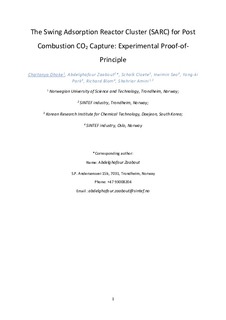| dc.contributor.author | Dhoke, Chaitanya | |
| dc.contributor.author | Zaabout, Abdelghafour | |
| dc.contributor.author | Cloete, Schalk Willem Petrus | |
| dc.contributor.author | Seo, Hwimin | |
| dc.contributor.author | Park, Yong-ki | |
| dc.contributor.author | Blom, Richard | |
| dc.contributor.author | Amini, Shahriar | |
| dc.date.accessioned | 2019-02-27T11:58:34Z | |
| dc.date.available | 2019-02-27T11:58:34Z | |
| dc.date.created | 2018-11-14T18:38:03Z | |
| dc.date.issued | 2018 | |
| dc.identifier.citation | Chemical Engineering Journal. 2018, 1-7. | nb_NO |
| dc.identifier.issn | 1385-8947 | |
| dc.identifier.uri | http://hdl.handle.net/11250/2587786 | |
| dc.description.abstract | This paper presents the first experimental demonstration of the novel swing adsorption reactor cluster (SARC) for post combustion CO2 capture. The SARC concept combines a temperature and vacuum swing for sorbent regeneration. A heat pump is used for transferring heat from the exothermic carbonation reaction to the endothermic regeneration reaction. Sorbent regeneration under vacuum allows for a small temperature difference between carbonation and regeneration, leading to a high heat pump efficiency. This key principle behind the SARC concept was demonstrated through lab-scale experiments comparing combined vacuum and temperature swing adsorption (VTSA) to pure temperature swing adsorption (TSA), showing that a 50 mbar vacuum can reduce the required temperature swing by 30–40 °C. A complete SARC cycle comprising of carbonation, evacuation, regeneration and cooling steps was also demonstrated. The cycle performed largely as expected, although care had to be taken to avoid particle elutriation under vacuum and the CO2 release rate was relatively slow. The SARC principle has therefore been successfully proven and further scale-up efforts are strongly recommended. | nb_NO |
| dc.language.iso | eng | nb_NO |
| dc.publisher | Elsevier | nb_NO |
| dc.rights | Attribution-NonCommercial-NoDerivatives 4.0 Internasjonal | * |
| dc.rights.uri | http://creativecommons.org/licenses/by-nc-nd/4.0/deed.no | * |
| dc.title | The swing adsorption reactor cluster (SARC) for post combustion CO2 capture: Experimental proof-of-principle | nb_NO |
| dc.type | Journal article | nb_NO |
| dc.type | Peer reviewed | nb_NO |
| dc.description.version | acceptedVersion | nb_NO |
| dc.source.pagenumber | 1-7 | nb_NO |
| dc.source.journal | Chemical Engineering Journal | nb_NO |
| dc.identifier.doi | 10.1016/j.cej.2018.10.082 | |
| dc.identifier.cristin | 1630660 | |
| dc.relation.project | Norges forskningsråd: 268507 | nb_NO |
| dc.description.localcode | © 2018. This is the authors’ accepted and refereed manuscript to the article. Locked until 9.10.2020 due to copyright restrictions. This manuscript version is made available under the CC-BY-NC-ND 4.0 license http://creativecommons.org/licenses/by-nc-nd/4.0/ | nb_NO |
| cristin.unitcode | 194,64,25,0 | |
| cristin.unitname | Institutt for energi- og prosessteknikk | |
| cristin.ispublished | true | |
| cristin.fulltext | postprint | |
| cristin.qualitycode | 1 | |

